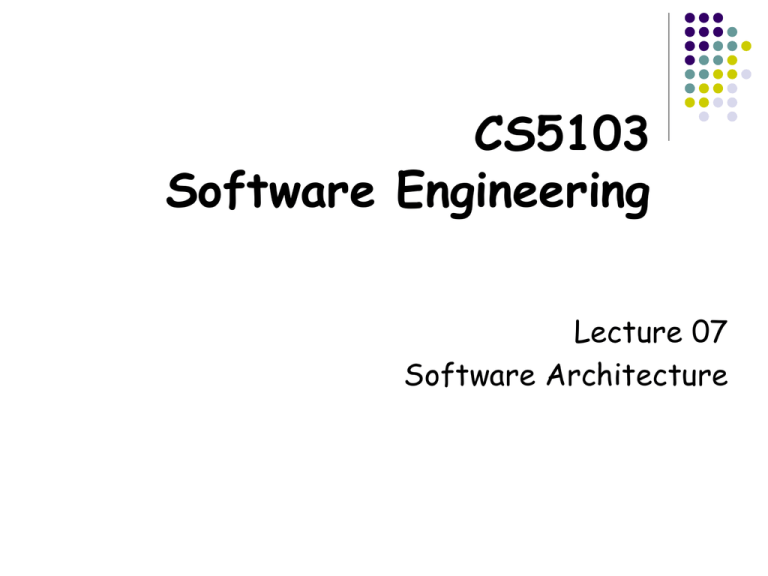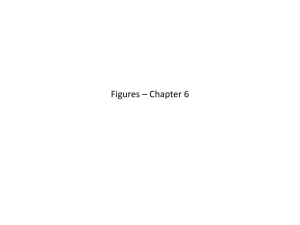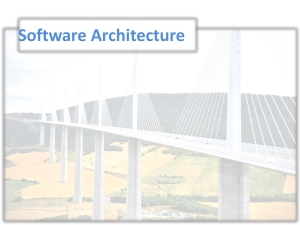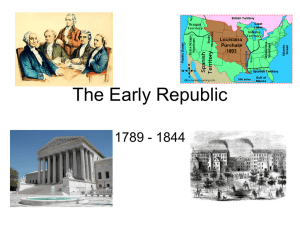Lecture 07 Software Architecture
advertisement

CS5103 Software Engineering Lecture 07 Software Architecture Today’s class 2 Software Architecture What is software architecture Why software architecture Software architecture styles What is software architecture 3 Software architecture is the structure of a software system – like the blue prints in building architecture Software components Details (data structure and algorithms) hidden Relationships among the components Relations can be vague Data flows Control flows Dependencies Why software architecture? Software becomes larger and larger 4 500 lines of code: just write it 5,000 lines of code: maybe class diagram (data flow diagram for non OO approaches) 500,000 lines of code: software architecture A simple class diagram 5 A class diagram with 300 classes 6 So we need higher level abstraction Consider higher level concepts in architecture : components For OO approach, components are usually a collection of classes Consider the bookstore project: 7 For a small book store: books, shelves, clerks But for barnes&noble: book storage, ads, finance, online stores, readers, bookstore is one component Software Architectural Design Usually used for large software projects and software frameworks Early phase design 8 Important for task assignment At a higher level than class diagrams Components and their relationship Interface can be vague at first Software Architectural Design Usually done by a small number of high-level people It can be both technical and artistic Experience and creativity can be major factors 9 It is not something you can learn well from the book But there is something to learn about it Software architecture styles Something like architecture styles for buildings 10 Certain way to organize components and their relationships Can be reused in different software Use different architecture styles according to the usages of software Architecture styles 11 Stadium Architecture styles 12 Stations and airports Architecture styles Skyscrapers Why no skyscrapers looking like a stadium? 13 Some times people try new styles… 14 Why Software architecture styles Easier to do high level design Barnes&Noble example Consider an architecture like this: Component Component Component Component 15 Component Component Why Software architecture styles Actually, most such information systems has an architecture like this, why? Application Service Data 16 Component Component Component Component Component Component Component Why Software architecture styles Reduce high level design risks People may have tried different styles and found this best (It is not as obvious as for buildings) The drawbacks of commonly used architectures are well studied You may try new ones: But not until you are a really good architect Popular architecture styles Pipe and Filter Layered Repository Pipe and Filter 19 A defined series of independent computations Performed for data transformation A component reads streams of data on its inputs and produces streams of data on its outputs Pipe and Filter 20 UTSA CS3773 Pipe and Filter: Structure Components: filter Perform changes on the data input and generate output Computation can be done with part of input, so that it can start before accepting all inputs Connectors: pipe Simply data transfer between filters Pipe and Filter: Characteristic 22 Filters do not share state with other filters Filters do not know the identity of their upstream or downstream filters The correctness of the output of a pipe and filter network shall not depend on the order in which their filters perform their incremental processing Pipe and Filter Examples Unix Shell Scripts: provides a notation for connecting Unix processes via pipes. e.g., cat file | grep err | wc Compilers: the phases in the pipeline include: 23 Lexical analysis Parsing Semantic analysis Code generation Pipe and Filter - Advantages 24 Easy to understand the overall input/output behavior of a system as a simple composition of the behaviors of the individual filters They support reuse, since any two filters can be hooked together, provided they agree on the data that is being transmitted between them Pipe and Filter - Advantages 25 Systems can be easily maintained and enhanced, since new filters can be added to existing systems and old filters can be replaced by improved ones The naturally support concurrent execution: mapreduce is actually pipe and filter architecture Pipe and Filter - Disadvantages 26 Not good for handling reactive systems, because of their transformational character Excessive parsing and un-parsing leads to loss of performance and increased complexity in writing the filters themselves Layered Style 27 The system is divided to multiple layers Each layer provides service to the layer above it and serves as a client to the layer below it Each layer may have multiple components, these components usually do not interact much with each other Layered Style 28 Layered Style: Structure Components: are typically collections of procedures Connectors: the layer margin, are typically procedure calls under restricted visibility Layer Communication Rules: Usually a component will talk only with the layer just beneath it Only carefully selected procedures from the inner layers are made available (exported) to their adjacent outer layer 29 Layered Style Examples Operating Systems Unix Windows Android …(almost any) Distributed Information Systems Web applications 30 Data/Logic/Appearance Layered Style Advantages 31 Design: based on increasing levels of abstraction Maintainability: changes to the function of one layer affects at most two other layers Reuse: different implementations (with identical interfaces) of the same layer can be used interchangeably Layered Style Disadvantages 32 Not all systems are easily structured in a layered fashion Performance requirements may force the coupling of high-level functions to their lower-level implementations Repository Style 33 Suitable for applications in which the central issue is establishing, augmenting, and maintaining a complex central body of information Typically the information must be manipulated in a variety of ways Often long-term persistence of information is required Repository Style 34 Repository Style: Structure Components: A collection of independent components that operate on the central data structure Connectors: 35 A central data structure representing the correct state of the system Typically procedure calls or direct memory accesses Repository Style: Characteristics Components only interact with the repository All components can access the repository 36 The repository controls and manages the access to its data Repository Style Examples Programming Environments Graphical Editors AI Knowledge Bases 37 Repository Style Advantages Efficient way to store large amounts of data Sharing model is published as the repository schema Centralized management: 38 backup security concurrency control Repository Style Disadvantages Must agree on a data model a prior Difficult to distribute data Data evolution is expensive 39 Today’s class UML 40 Sequence Diagram Software Architecture What is architecture Why architecture Architecture styles Next class 41 Software Design Principles Design Patterns Definition Reasons and Advantages Some Useful design patterns Composite Factory Visitor Thanks! 42











